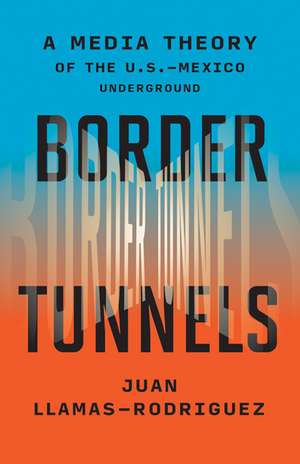Border Tunnels: A Media Theory of the U.S.-Mexico Underground
Autor Juan Llamas-Rodriguezen Limba Engleză Paperback – 17 oct 2023
A comparative media analysis of the representation of the U.S.–Mexico border
Border tunnels at the U.S.–Mexico border are ubiquitous in news, movies, and television, yet, because they remain hidden and inaccessible, the public can encounter them only through media. Analyzing the technologies, institutional politics, narrative tropes, and aesthetic decisions that go into showing border tunnels across multiple forms of media, Juan Llamas-Rodriguez argues that we cannot properly address border issues without attending to—and fully understanding—the fraught relationship between their representation and reality.
Llamas-Rodriguez reveals that every media text about border tunnels, whether meant for entertainment, cable news, video games, or speculative design, implicitly takes a position on the politics of the border. The examples laid out in Border Tunnels will teach readers how to look differently at the border as it is commonly presented in various forms of media, from ABC’s Nightline and CNN’s Anderson Cooper 360º to reality TV, propaganda videos, and even digital effects in Hollywood action films. Llamas-Rodriguez examines how creative decisions in the production, promotion, and distribution of these media texts either emphasize or downplay issues such as border security, racial dynamics of migration, and sustainability of the borderlands.
Focusing on tunnels to show how media representations can influence all kinds of audiences—even those physically near the border—Border Tunnels helps us make sense of this pressing social issue, ultimately advancing understanding of the U.S.–Mexico border in all of its complexity and precariousness.
Border tunnels at the U.S.–Mexico border are ubiquitous in news, movies, and television, yet, because they remain hidden and inaccessible, the public can encounter them only through media. Analyzing the technologies, institutional politics, narrative tropes, and aesthetic decisions that go into showing border tunnels across multiple forms of media, Juan Llamas-Rodriguez argues that we cannot properly address border issues without attending to—and fully understanding—the fraught relationship between their representation and reality.
Llamas-Rodriguez reveals that every media text about border tunnels, whether meant for entertainment, cable news, video games, or speculative design, implicitly takes a position on the politics of the border. The examples laid out in Border Tunnels will teach readers how to look differently at the border as it is commonly presented in various forms of media, from ABC’s Nightline and CNN’s Anderson Cooper 360º to reality TV, propaganda videos, and even digital effects in Hollywood action films. Llamas-Rodriguez examines how creative decisions in the production, promotion, and distribution of these media texts either emphasize or downplay issues such as border security, racial dynamics of migration, and sustainability of the borderlands.
Focusing on tunnels to show how media representations can influence all kinds of audiences—even those physically near the border—Border Tunnels helps us make sense of this pressing social issue, ultimately advancing understanding of the U.S.–Mexico border in all of its complexity and precariousness.
Preț: 185.46 lei
Nou
Puncte Express: 278
Preț estimativ în valută:
35.49€ • 37.05$ • 29.37£
35.49€ • 37.05$ • 29.37£
Carte disponibilă
Livrare economică 14-28 martie
Livrare express 27 februarie-05 martie pentru 23.99 lei
Preluare comenzi: 021 569.72.76
Specificații
ISBN-13: 9781517914295
ISBN-10: 1517914299
Pagini: 272
Ilustrații: 80 black and white illustrations
Dimensiuni: 140 x 216 x 18 mm
Greutate: 0.34 kg
Editura: University of Minnesota Press
Colecția Univ Of Minnesota Press
ISBN-10: 1517914299
Pagini: 272
Ilustrații: 80 black and white illustrations
Dimensiuni: 140 x 216 x 18 mm
Greutate: 0.34 kg
Editura: University of Minnesota Press
Colecția Univ Of Minnesota Press
Notă biografică
Juan Llamas-Rodriguez is assistant professor of global media in the Annenberg School for Communication and affiliated faculty with the Center for Latin American and Latinx Studies at the University of Pennsylvania.
Cuprins
Contents
Introduction: A Media Theory of the Border Tunnel
1. TV News and Spectacle
2. Reality TV and Performativity
3. Digital Animation and Plasticity
4. First-Person Shooters and Racialization
5. Speculative Design and Sustainability
Conclusion: Media Theory from the Border Tunnel
Acknowledgments
Notes
Index
Introduction: A Media Theory of the Border Tunnel
1. TV News and Spectacle
2. Reality TV and Performativity
3. Digital Animation and Plasticity
4. First-Person Shooters and Racialization
5. Speculative Design and Sustainability
Conclusion: Media Theory from the Border Tunnel
Acknowledgments
Notes
Index
Recenzii
"Don’t miss this provocative and impressive study of the mediated imaginings and construction of the U.S.–Mexico border. Juan Llamas-Rodriguez’s Border Tunnels provides an original and illuminating investigation of the complex and intertwined subjects of U.S.–Mexico relations, media narratives and video games that focus on border security, and the political rhetoric of marginalization." —Mary Beltrán, author of Latino TV: A History
"Juan Llamas-Rodriguez pushes the limits of media theory to help us think about borders, tunnels, and the complex social and material interrelations that define the U.S.–Mexico border. Subtle, creative, and theoretically sophisticated, Border Tunnels compels us to look at these material structures as media, as social organizers crafted by popular culture, policy, myth, engineering, and surveillance technologies." —Hector Amaya, author of Trafficking: Narcoculture in Mexico and the United States
"Juan Llamas-Rodriguez pushes the limits of media theory to help us think about borders, tunnels, and the complex social and material interrelations that define the U.S.–Mexico border. Subtle, creative, and theoretically sophisticated, Border Tunnels compels us to look at these material structures as media, as social organizers crafted by popular culture, policy, myth, engineering, and surveillance technologies." —Hector Amaya, author of Trafficking: Narcoculture in Mexico and the United States
